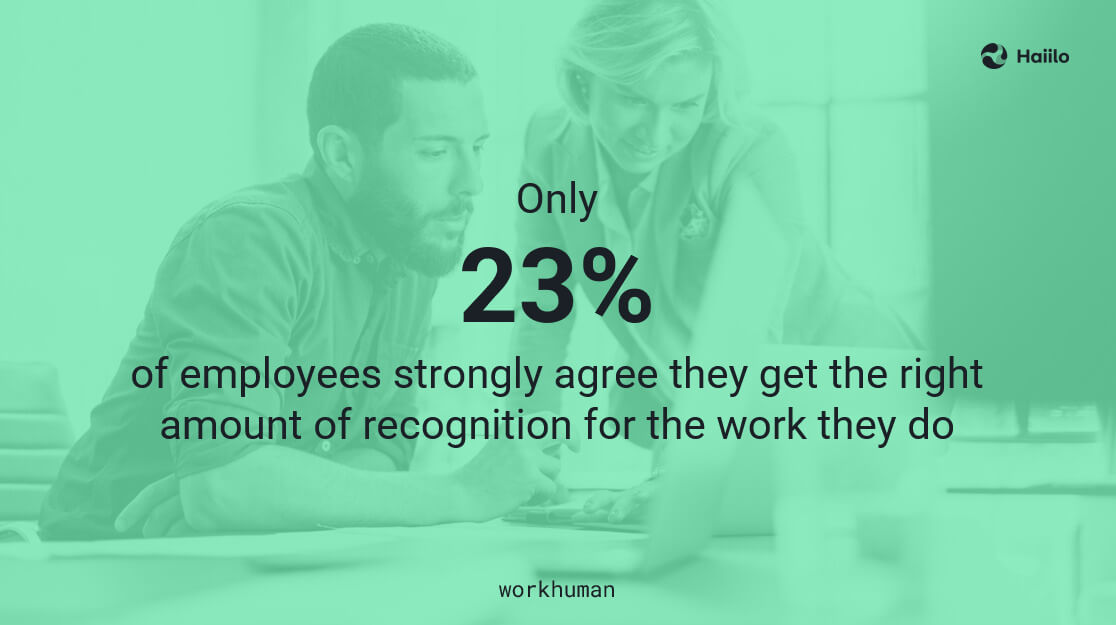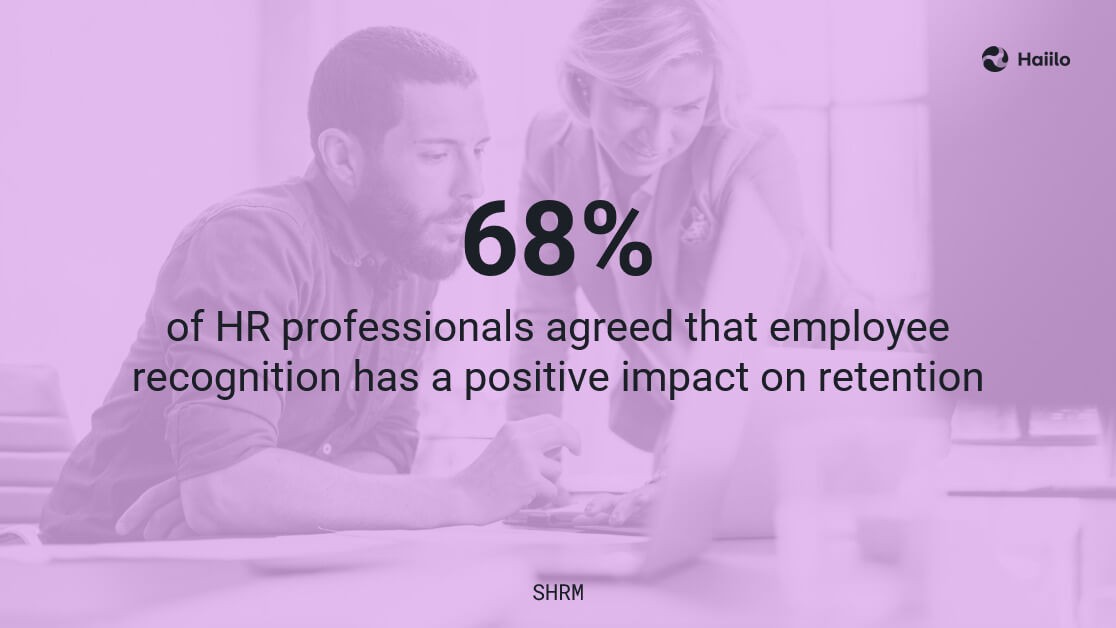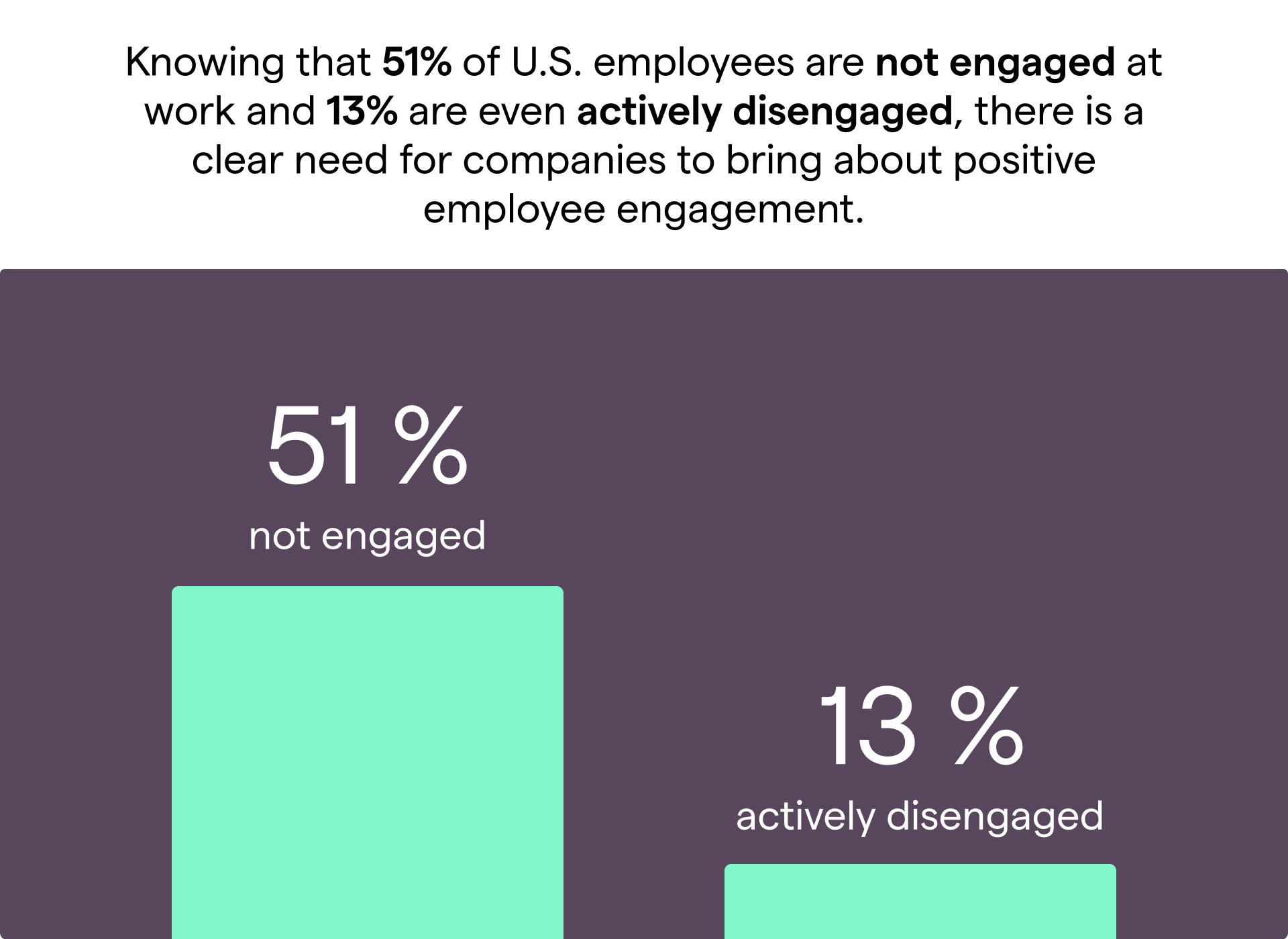Most companies that care about their employees’ experience have already implemented employee recognition programs. However, too many of those still neglect the power and benefits of employee appreciation.
Lack of employee recognition is one of the biggest culprits for low engagement and high turnover rates. Hence, it is no surprise that the popularity of employee recognition initiatives within organizations has been increasing exponentially.
The new report found that only 23% of employees strongly agree they get the right amount of recognition for their work. At the same time, 36% of organizations with an employee recognition program have a huge leg up against their competition.

In this blog, we will cover the benefits of having an employee recognition program, steps for implementing a successful program, and out-of-the-box ideas to make the programs more engaging and fun for employees.
What Is an Employee Recognition Program
Employee recognition programs are usually set up and managed by HR departments. These programs usually consist of various initiatives to boost employee engagement and productivity through acts of appreciation for certain activities or behaviors employees take. The programs are usually designed to maintain high standards of behavior, provide motivation and feedback to employees and publicly praise big wins, hard work, and dedication.
They should have a set of policies and procedures explaining how recognition should be done so that it delivers the best possible outcomes.
Furthermore, employee recognition programs should be backed by designated technology that makes the entire process more streamlined, measurable, and easier to manage.
Even though there are many different types of employee recognition programs, we can split them into two main categories:
Monetary programs
Monetary employee recognition program is a program in which appreciation is followed by a monetary reward such as:
- Cash
- Gift-cards
- Bonuses
- Free meals
- Paid training opportunities, scholarships, or other career development opportunities
- Gym memberships
- Other
Non-monetary programs
An employee recognition program doesn’t have to be monetary to be successful. According to a study by the Incentive Research Federation for the Incentive Marketing Association, 65% of employees prefer non-monetary incentives instead of monetary rewards.
The goal of most non-monetary programs is to simply make appreciation one of the core company values by embedding appreciative behavior in every employee.
They are not followed by a monetary award. However, there are examples of other non-monetary awards than just saying thanks:
- Day off
- Time for volunteer work
- Work from home (more flexible work schedule)
- A better parking spot for a week
- A lunch or a chat with the CEO or other leader in your company
- Mentorship day
- Other
Build a culture of appreciation with Haiilo employee communications platform!
Why Every Company Should Have an Employee Recognition Program
Let’s take a look at the biggest benefits of building a culture of appreciation in your organization.
1. Employee engagement and producitivty
Based on Korn Ferry’s findings, many organizations primarily view recognition programs as a way to engage and motivate employees. To be more specific, Harvard Business Review reported that 72% of business leaders rank recognition as having a significant impact on employee engagement.
Another research suggests that social recognition can improve individual performance by up to two times and raise productivity by over 60% on average.
💡 Related: Top 15 Employee Motivation Tips and Benefits
2. Employee retention
According to an Indeed survey, 30% of people who left a job within the first six months said being recognized more for their unique contributions could have helped them stay longer. Furthermore, SHRM/Globoforce survey, Using Recognition and Other Workplace Efforts to Engage Employees, 68% of HR professionals agreed that employee recognition has a positive impact on retention.

💡 Also, learn about the 9 ways to combat employee turnover in your company!
3. Employee attraction (talent acquisition)
In the previously mentioned research by SHRM, 56% of HR professionals said employee recognition programs also help with recruitment and employer branding. Organizations listed under the “great places to work” category are typically those that frequently recognize outstanding work.
💡Related: How To Attract, Engage, and Retain Gen Z In the Workplace
4. Employee advocacy
Employee recognition can be a powerful tool for encouraging employee advocacy in the workplace. Employee ambassadorship can be one of the best ways to boost a company’s brand awareness, sales, and employer branding.
However, ambassadorship should be recognized and rewarded to work long term. So consider implementing an employee recognition program designated to show your employees how much you appreciate them sharing your company’s content with their own networks.
5. Customer service
Employee recognition programs are great because they can be aligned with any KPI critical for your organization’s success. For most companies, that is customer satisfaction and loyalty.
So if you wish to improve customer-facing KPIs in your organization, consider incentivizing those employees who have the biggest impact on them.
Also, great customer satisfaction usually begins with happy employees. According to data, 35% of companies with a recognition program notice increased customer satisfaction.
6 Steps to Build a Successful Employee Recognition Program
Next, we will cover the 6 must-follow steps to implement and manage a successful employee recognition program.
1. What type of program will you implement?
First of all, you need to decide whether your recognition program will be monetary or non-monetary. Based on the budget you have, you can then decide about the awards that will be provided.
Next, you need to define eligibility requirements as well as thresholds for awards. Finally, think about the approval processes. Will recognitions and associated rewards have to be approved before they are sent out?
Instead of guessing what types of awards motivate your employees, you can ask them so in a simple survey. Based on the findings, you can offer awards that will impact your employees’ experience in the workplace.
2. How will you get employees’ and leadership’s buy-in and engagement?
Lack of employee and leadership buy-in is often the biggest culprit for the failure of employee recognition programs.
When implementing the program, you need to make sure that you also have an appropriate internal communication strategy in place. Frequently communicating the benefits of employee recognition and providing content about best practices for giving recognition can significantly increase employees’ participation in the program.
📹 Check out our Masterclass about why you need an internal comms strategy!
3. What channels will employees use to give praise?
Recognition should be easily done. Don’t expect your employees to go to designated recognition software every time they want to give praise.
Rather, they should be able to recognize their peers directly from the messaging or communication tool they use daily.
You can implement a #kudos channel inside your intranet or your instant messaging solution.
4. What will be the reasons for recognition?
This is a critical step that can make or break your employee recognition program. Reasons for recognition should be tied to the ultimate business goals or core company values.
Aligning reasons for recognition can help you achieve your business’s goals and objectives and help employees understand the desired actions and behaviors needed to achieve them.
5. Will the recognition be public or private?
Even though some companies still prefer recognition to be private, research has proved that social recognition has many benefits.
Whenever possible (when employees are fine with it), make recognition visible to the rest of the workforce. For example, recognitions could be visible in a public channel or appear in the news feed of your company’s social intranet.
This is a great way to build a positive workplace culture!
💡 Also, learn about the ultimate guide for building a corporate culture employees will want to be a part of.
6. How will you measure the success of the program?
Besides just measuring how engaged your employees are with the program, you should track the impact of recognition on the ultimate business goals.
If you have aligned recognition with the business KPIs, this should be fairly easy to do using the before-and-after analysis. Compare how much your business KPIs have improved with the implantation of the recognition program.
6 Employee Recognition Program Ideas
When implementing employee recognition programs, many employers start with simple initiatives such as years of service awards and birthdays. But If you need some additional inspiration to make the programs more fun, we have put together a list of ideas for you.
1. Employee of the month award
Every month, you could ask your workforce to nominate one person they think deserves the title of employee of the month.
After nominations, you can have a voting period during which everyone can give their vote to one of the nominees.
This type of award can be done on a monthly, quarterly, or yearly basis.
The winners can be announced on your company’s intranet news feed or in an internal employee newsletter you send to your employees.
2. The customer lover award
If customer service is important to you, you should definitely have an employee recognition program to give extra motivation to your CS teams.
If you are tracking your employees’ performance through customer facing surveys, the best (and most fair) option is to tie the recognition with the survey results. The employee with the best record should be the winner of this award.

3. The biggest ambassador award
If employee advocacy and ambassadorship are important to your organization, consider implementing a reward that will encourage employees to act as brand advocates.
If you have an employee advocacy solution implemented, it should be fairly easy to measure who in your organization is most engaged when it comes to sharing your company’s content on their private social media profiles.
4. Leadership award
Hopefully, bottom-up feedback is something your company practices. If so, you should be able to identify leaders with the most positive quarterly reviews.
These leaders could be publicly recognized on your organization’s wall of fame so that other leaders get extra motivation to improve their leadership skills.
5. Living by core values award
If you care that your employees live by your company’s core values, implement a program that aligns with those values. For example, if continuous learning is one of the values your company is trying to promote, then recognize those who actively invest in their knowledge.
If honesty is what your company stands for, then show appreciation to those who consistently act and communicate in an honest and transparent way.
Another example of a core company value is teamwork. If this is true for your organization, implement a designated program for those who show excellent teamwork skills.
6. The true appreciator award
One of the best ways to drive more engagement with your recognition programs is by rewarding those who actively participate.
On a monthly or quarterly basis, you could reward those who sent the most recognition to their peers.










